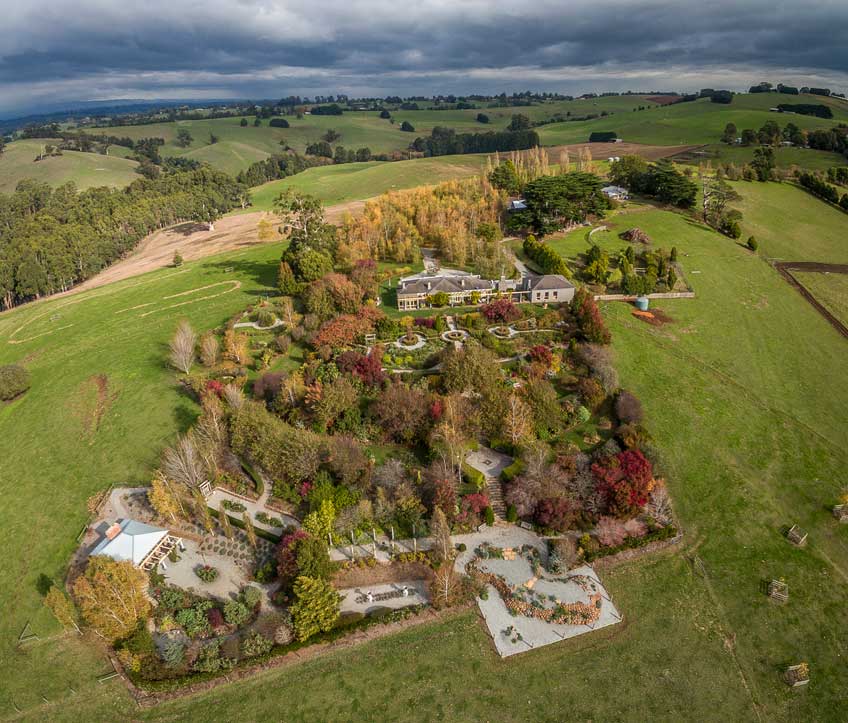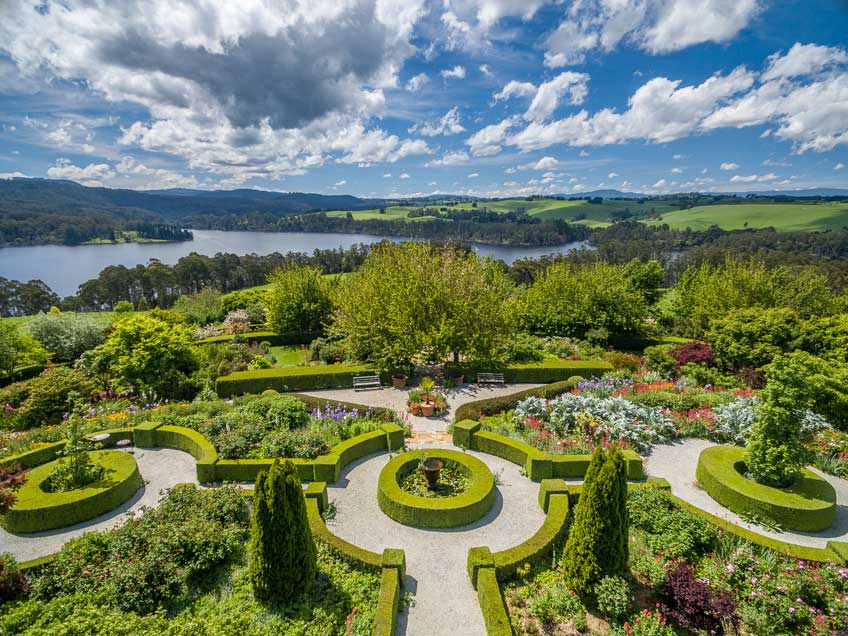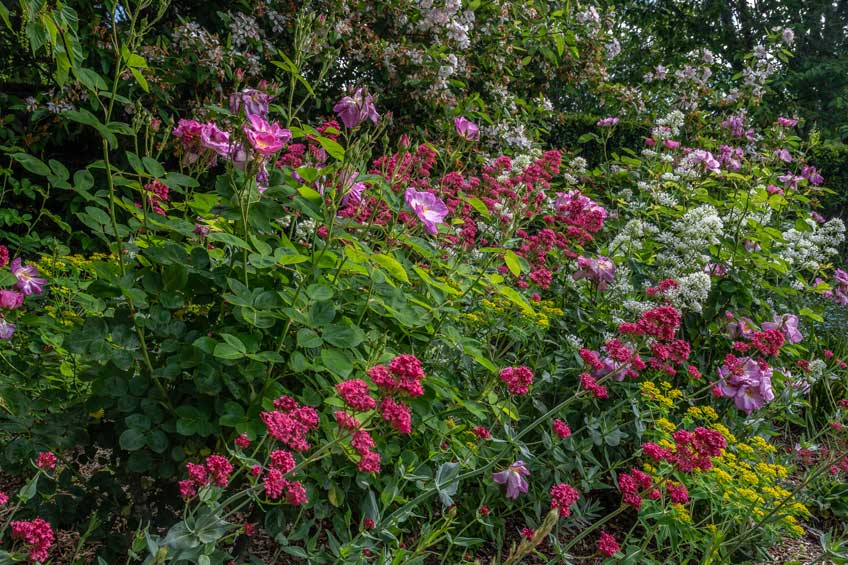Winter is a busy time in the garden as we prepare for the big show that is spring.
Find out what David Musker is up to at the stunning Garden at Broughton Hall in Victoria.
Words: David Musker, pictures: Terri O’Dwyer

The vista of Broughton Hall from the air gives an idea of it's scale.
We came across this property in Jindivick 24 years ago and fell in love with its potential. Neither of us had thought of owning a farm but I wanted that
north-facing slope with its view of the Tarago reservoir for a garden. Eighteen months later our new home was on top of the ridge in the middle of
the farm, and we had already begun setting its scene, planting 500 trees in what was to be our birch forest. I have added 30 more each year and though
we have lost a few to mowers, cows and the weather the majority stand today as a testament to the rich red soil and the suitable rainfall.
The garden was to be tiered down the slope facing the view with a central axis as the main element holding the layers of the garden together. The design
created the opportunity to treat spaces differently without interrupting the garden’s cohesive flow. Today we still plant and replant, build walls,
add pots and change things around: it is a magic space to live and work in and I can’t imagine ever finishing it. The joy it brings is evident everywhere
within it and it continues to be an amazing privilege to have designed, constructed, planted and maintained it over this time.
I’m admiring the hedging
I love hedging because of the dramatic contrast it can create in a garden, from sharp lines of dark green with autumn leaves falling on them to roses cascading
over them in abundance in spring, but it’s the look of bare trees, sharp green hedges and mist over the garden that for me is the most evocative image
hedging can offer.

Sharply contrasting hedges against the cascading foliage within
We use English box in the upper garden because of its dense green colour and the sharp effect you can achieve with careful pruning. It’s pruned twice a
year, in early-spring and mid-autumn. We check the weather forecasts to ensure that there are no days over 24 C in the week after pruning as box can
burn easily in hot dry weather.
Lower down the garden we have used box privet, Lugustrum undulatum, which is hardier, grows quickly and can be easily pruned to a sharp surface.
It needs less water than English box and next to no feeding, but it does grow very quickly and needs pruning every six weeks through the growing season.
Fortunately once the nights cool it stops growing and is dormant until spring.
I’m trimming the cherries
In early October each year the garden comes alive with cherry blossom. We celebrate this time of year by opening the garden and encouraging people to visit,
picnic and enjoy the fabulous visual feast. In winter we prepare by pruning the cherry trees. We remove dead wood, branches that have encroached on
pathways and garden beds and aim to keep the trees healthy by keeping them as open as is possible. We no longer feed these huge trees but the beds
they sit in are heavily mulched in winter and we do water in autumn if it gets very dry, to minimise stress and guarantee a spectacular spring display.

Spectacular mature cherries
The garden is exposed to northerly and easterly winds, but the cherries are are in the centre of the garden, protected by other trees, hedging and the
initial sculpting of the site we did to encourage the wind up and over the garden rather through it.
I’m encouraging volunteers
In a garden of this size, some six acres, it is very helpful to let some plants self-seed and spread in a controlled way. Here Californian poppies have
been allowed to seed and spread under the David Austin rose ‘Golden Celebration’. The poppies are a perfect colour and foliage contrast to the rose
and bulk up the bed nicely. In June we remove all the spent poppy plants, then mulch and feed the bed. By spring it will be full again from the seedlings
of the last season’s plants. This is amost satisfactory process and often comes with a colour surprise, with natural variation offering tones from
pink to white to yellow to orange.

'Golden Celebration' amongst the poppies
I’m pruning the roses
Rose pruning is done in July each year. We cut back by 50 percent in some beds, while leaving the old-fashioned roses a bit wilder. I like the look of
foliage cascading over hedging and spilling into the paths but this has to be created carefully each year. Each year I try a different look in different
areas. To create this look in this bed, I first cut back the roses, then cut the valerian quite harshly. The perennials were removed and divided. Iris
and euphorbia were replanted to create a full combination of contrasting foliage and flower in all areas.

Roses are cut back 50% each July
Once the plants are in place, I weed and mulch heavily.(Being in the middle of a farm we get seed blowing into the garden regularly and have to keep mulching
beds to suppress weeds.) Finally I feed each rose in the garden two handfuls of Dynamic Lifter late in July and give all beds a few handfuls of rock
dust. Together this stimulates healthy growth and by August we see signs of life in the borders and by October they are bursting with growth and flowers.
It’s time to
Plant tulips. I like two or three permanent plantings in a set of pots, and seasonal change in the others. We plant tulips and narcissus bulbs in early
June.
Prune the box balls and hedges around the cherry trees in late August, so they look perfect at cherry time.
Cut some of the Californian tree poppy to the ground so they flower at waist height the following season and leave a few unpruned to give flowers floating
in the sky.
Wander the garden from different directions to give me a good understanding of the volume of the plants before we start pruning. I like the plants in my
garden to grow into each other. The look I’m after is just this side of out-of-control - full and abundant.
Rake the gravel. We use a mesh rake dragged behind a ride-on mower to rake up leaves in front of the garden room and at the forecourt to the house and
raked the paths regularly by hand.
Digging up seedlings and replanting them into the garden or potting them up to sell in the nursery is a year-round job.
See more
David has chosen some unusual varieties of plants at Broughton Hall. Here he gives us six plants he loves in the garden at winter time.
The Garden at Broughton Hall is open on the first two weekends of October for cherry blossom season. For details see www.jindivickcountrygardener. The Garden at Broughton Hall is on our Inside Victoria itinerary for spring. Call 1300 233 200 for details.